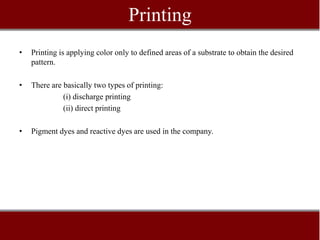
Printing
- 1. Printing • Printing is applying color only to defined areas of a substrate to obtain the desired pattern. • There are basically two types of printing: (i) discharge printing (ii) direct printing • Pigment dyes and reactive dyes are used in the company.
- 2. PRINT PASTE INGREDIENTS DYE USED RECIPE TREATMENT COMMENTS Pigment + binder + thickener + softener + Print-dry-cure (at Low cost + Time Pigment Dyes surfactant + urea 150˚C, for 5-6 min) Saving (hygroscopic agent) + anti choking agent (if required). Sodium Alginate + NaHCO3 (fixing agent) + Print-dry-ageing (i.e. Hexa Metaphosphate (water Reactive Dyes steam 102˚C)- wash- Nil softener) + Soda Ash saturated steam (Oxidation) + urea (hygroscopic agent) Binder + Urea (hygroscopic Print-dry-ageing (i.e. Rangolite SE (for Discharge Printing agent) + thickener (HEF) + steam 102˚C)- wash- discharge) Softener + Pigment saturated steam
- 3. Design Studio Re-generated “Software Swatch sample Photo shop” “Spec Sheet” 1st 2nd 3rd
- 4. Printing Machine Machine Name Type 1 Ichinose Rotary Screen Printing Machine 1 Baby Screen Printing Machine Rotary Screen Printing Machine 1 Strike Off Manual flat-bed screen printing Manual Flat-bed Screen Printing M/C Rotary Screen Printing M/C
- 5. Hand Screen Printing Purpose Sampling Process Check the out come Screen Printing consists of three elements : Mesh Stencils Squeeze
- 6. Hand screen printing • Printing process involves following steps: The print paste is prepared using binder, water and dyestuff.1 kg binder is used for every 10 g of color. The table top is a sandwich of a rubber blanket, a cotton fabric and a resin coated screen. The fabric is glued on to the table top & the screen is placed over the fabric; the print paste is poured over it and spread on the fabric manually by a wooden squeegee.
- 7. Rotary Sample Printing Machine Machine used • Sampling Machine – Baby Rotary • To check the fabric in garment form. screen printing Machine Parts - •Transporting Roller •Crease Removing Roller •14 Printing Rollers •Nickel Screen
- 8. Screen development • Nickel screen mesh is coated with photo-emulsion. • The screen mesh is dried at 150˚C for 5 minutes. • The machine has software which is used to print designs. The design is fed into the machine using a CD. • As per the design entered, photo-ink is sprayed on the mesh. The ink displaces the photo-emulsion. • It is then washed with water to unclog the pores and after this the screen is ready to be used.
- 9. ROTARY SCREEN PRINTING • Name of the machine – Ichinose • Used for the bulk production. • Average speed of m/c - 16 m/min. • Average productivity – 8000-10,000 m/shift • Maximum no. of screen possible – 14 • Speed : complexity of design increases – speed of the production decreases. • Average speed - 16 m/min
- 10. Printing paste preparation • The ingredients found in paste formulations include the following: dyes or pigments, thickeners, sequestering agents, dispersing or suspending agents (surfactants), water-retaining agents (humectants), defoamers, catalysts, and hand modifiers. • In addition to the ingredients, pigments require a binder or resin system to fix the pigment and may include adhesion promoters • For blended fabrics pigments are used, which are not dyes but are colored particles glued to the surface of the fabrics.
- 11. Soaping and washing • After the printing is over the printed fabric is sent to soaping/washing and then dried. • Soaping is done after pigment printing and washing is done after discharge printing. • Yamuna soaper machine is used for washing, soaping and drying. • Machine runs at the speed between 10 Mts. /min to 30 Mts. /min. • Contact time between the printed fabric and soaping agent is 5-6 minutes.
- 12. Printing defects Some of the printing defects are: Improper positioning of print Fluff Sharpness/blurr Joint marks